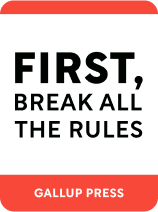

This article is an excerpt from the Shortform book guide to "First, Break All the Rules" by Gallup Press. Shortform has the world's best summaries and analyses of books you should be reading.
Like this article? Sign up for a free trial here .
Looking for First, Break All the Rules quotes by Marcus Buckingham? What are some of the most noteworthy passages worth revisiting?
In First, Break All the Rules, Marcus Buckingham lays out the Four-Key management roadmap that will help you hire the right people, create a productive working environment, and guide employees to success. The following quotes and passages highlight some of his key recommendations and management best practices discussed in the book.
Keep reading for First, Break All the Rules quotes by Marcus Buckingham.
First, Break All the Rules: Quotes by Marcus Buckingham
In First, Break All The Rules, Marcus Buckingham simply and clearly lays out proven management best practices. Here are some of the most noteworthy First, Break All The Rules quotes with explanations.
“Measuring the strength of a workplace can be simplified to twelve questions. These twelve questions don’t capture everything you may want to know about your workplace, but they do capture the most information and the most important information. They measure the core elements needed to attract, focus, and keep the most talented employees. Here they are: Do I know what is expected of me at work? Do I have the materials and equipment I need to do my work right? At work, do I have the opportunity to do what I do best every day? In the last seven days, have I received recognition or praise for doing good work? Does my supervisor, or someone at work, seem to care about me as a person? Is there someone at work who encourages my development? At work, do my opinions seem to count? Does the mission/purpose of my company make me feel my job is important? Are my co-workers committed to doing quality work? Do I have a best friend at work? In the last six months, has someone at work talked to me about my progress? This last year, have I had opportunities at work to learn and grow? These twelve questions are the simplest and most accurate way to measure the strength of a workplace.”
To determine how well you’re finding, engaging, and maintaining strong employees, you need a precise and thorough way to gauge the strength of your organization. The Q12 Items are 12 question items to give to your employees that help you determine the strength of your organization. Managers have the most direct impact on high Q12 scores because they interact with employees on a daily basis and dictate the tone of leadership.
Employees respond to the Q12 on a scale of 1 (strongly disagree) to 5 (strongly agree). The items are as follows:
- I know what my company expects from me.
- I have the tools to effectively do my job.
- I have the opportunity to put my best talents to use every day.
- In the past week, I have been recognized for strong work.
- My manager, or someone else at work, cares about me as a human being.
- Someone at work promotes my development.
- My opinion matters.
- My company’s mission makes me feel like my job matters.
- My fellow employees commit to doing good work.
- I’ve made a best friend at work.
- Someone has talked to me about my development in the last six months.
- In the last year, I’ve had learning opportunities at work.
“Of the twelve, the most powerful questions (to employees, gauging their satisfaction with their employers) are those with a combination of the strongest links to the most business outcomes (to include profitability). Armed with this perspective, we now know that the following six are the most powerful questions:
1) Do I know what is expected of me at work?
2) Do I have the materials and equipment I need to do my work right?
3) Do I have the opportunity to do what I do best every day?
4) In the last seven days, have I received recognition or praise for good work?
5) Does my supervisor, or someone at work, seem to care about me as a person?
6) Is there someone at work who encourages my development?As a manager, if you want to know what you should do to build a strong and productive workplace, securing 5s to these six questions would be an excellent place to start.”
In order to build a productive and satisfied workforce, you need to focus on items 1-6 before you attempt to develop 7-12. They build a foundation of connection and trust that allows you to develop relationships and focus on growth. Aiming to solve the higher-level questions before you establish your base will lead to interesting concepts that you won’t be able to execute. For instance, if you haven’t laid out expectations for your employees, you can’t expect them to focus on the quality of their work because they have no reference for your definition of “quality work.”
“People don’t change that much. Don’t waste time trying to put in what was left out. Try to draw out what was left in. That is hard enough.”
Here, Buckingham is discussing the limits of training. He is a firm believer that no amount of training can exceed an inherent talent. There is only so much that a person can change. Therefore, he recommends leaders to hire for talent, not experience or determination.
“Spend the most time with your best people. … Talent is the multiplier. The more energy and attention you invest in it, the greater the yield. The time you spend with your best is, quite simply, your most productive time. … Persistence directed primarily toward your non-talents is self-destructive. … You will reprimand yourself, berate yourself, and put yourself through all manner of contortions in an attempt to achieve the impossible.”
Traditionally, managers feel the need to spend more time with employees who are struggling because they think that’s the best approach to increase overall productivity. They tend to spend time trying to instruct or control these employees to increase performance.
Great managers focus on turning talent into performance, not controlling or instructing their team members. They create ways to help employees unleash their potential through their individual talents by doing the following:
- Creating unique expectations. Each employee is motivated by different things. Great managers take the time to create individualized goals for each employee to strive for.
- Focusing on unique styles. Great managers make sure employees can use their unique talents and respect the ways that they approach the work.
- Protecting team members. Great managers know when to run interference between team members and leadership. They know how to play the administrative game to make sure their employees are in a position to succeed.
The more talents an employee uses, the more potential they possess. With this in mind, great managers can’t help but be drawn in by their most talented employees as it’s a more efficient use of their efforts. As you begin to put more energy into your best employees, keep the following tips in mind:

———End of Preview———
Like what you just read? Read the rest of the world's best book summary and analysis of Gallup Press's "First, Break All the Rules" at Shortform .
Here's what you'll find in our full First, Break All the Rules summary :
- Why only 13% of the world’s workforce is actively engaged at work
- How to find strong employees and keep them
- The 12 questions to ask your employees that help you determine the strength of your organization






